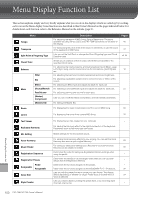Yamaha CVP-709 CVP-709/705 Owners Manual - Page 95
Connecting an External Monitor ([RGB OUT] terminal), Using an External Stereo System for Playback
 |
View all Yamaha CVP-709 manuals
Add to My Manuals
Save this manual to your list of manuals |
Page 95 highlights
Minimizing noise of the input sound via Noise Gate By default, this instrument cuts unwanted noise from the input sound. However, this may result in wanted sounds also being cut, such as the soft decay sound of a piano or acoustic guitar. To avoid this, set the Noise Gate to off via [Menu] [Utility] [Speaker/ Connectivity] [AUX In Noise Gate]. Using an External Stereo System for Playback You can connect a stereo system to amplify the instrument's sound by using the AUX OUT [L/L+R]/[R] jacks. The microphone or guitar sound connected to the instrument's [MIC/LINE IN] jack is output at the same time. NOTICE • To avoid possible damage, first turn on the power to the instrument, then to the external device. When turning off the power, first turn off the power to the external device, then to the instrument. Since this instrument's power may automatically be turned off due to the Auto Power Off function (page 19), turn off the power to the external device, or disable Auto Power Off when you do not intend to operate the instrument. • Do not route the output from the [AUX OUT] jacks to the [AUX IN] jacks. If you make this connection, the signal input at the [AUX IN] jacks is output from the [AUX OUT] jacks. These connections could result in a feedback loop that will make normal performance impossible, and may even damage the equipment. Instrument Powered speaker Phone plug (standard) Audio cable Input jack Phone plug (standard) Audio signal NOTE • Use only the [L/L+R] jack for connection with a monaural device. • Use an appropriate adaptor plug if the input jack of the powered speaker does not match the phone plug of the audio cable. • Use audio cables and adaptor plugs having no (zero) resistance. Connecting an External Monitor ([RGB OUT] terminal) CAUTION Avoid looking at the television or video monitor for prolonged periods of time since doing so could damage your eyesight. Take frequent breaks and focus your eyes on distant objects to avoid eye strain. By connecting with an external monitor such as a television to the [RGB OUT] terminal of the instrument, the lyrics and text on the instrument's display can be shown on the television or the monitor. Instrument External monitor Mini D-sub 15-pin Connections - Using Your Instrument with Other Devices - CVP-709/CVP-705 Owner's Manual 95















